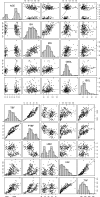IVGTT glucose minimal model covariate selection by nonlinear mixed-effects approach
- PMID: 20103736
- PMCID: PMC2867373
- DOI: 10.1152/ajpendo.00656.2009
IVGTT glucose minimal model covariate selection by nonlinear mixed-effects approach
Abstract
Population approaches, traditionally employed in pharmacokinetic-pharmacodynamic studies, have shown value also in the context of glucose-insulin metabolism models by providing more accurate individual parameters estimates and a compelling statistical framework for the analysis of between-subject variability (BSV). In this work, the advantages of population techniques are further explored by proposing integration of covariates in the intravenous glucose tolerance test (IVGTT) glucose minimal model analysis. A previously published dataset of 204 healthy subjects, who underwent insulin-modified IVGTTs, was analyzed in NONMEM, and relevant demographic information about each subject was employed to explain part of the BSV observed in parameter values. Demographic data included height, weight, sex, and age, but also basal glycemia and insulinemia, and information about amount and distribution of body fat. On the basis of nonlinear mixed-effects modeling, age, visceral abdominal fat, and basal insulinemia were significant predictors for SI (insulin sensitivity), whereas only age and basal insulinemia were significant for P2 (insulin action). The volume of distribution correlated with sex, age, percentage of total body fat, and basal glycemia, whereas no significant covariate was detected to explain variability in SG (glucose effectiveness). The introduction of covariates resulted in a significant shrinking of the unexplained BSV, especially for SI and P2 and considerably improved the model fit. These results offer a starting point for speculation about the physiological meaning of the relationships detected and pave the way for the design of less invasive and less expensive protocols for epidemiological studies of glucose-insulin metabolism.
Figures






Similar articles
-
Population and individual minimal modeling of the frequently sampled insulin-modified intravenous glucose tolerance test.Metabolism. 2004 Oct;53(10):1349-54. doi: 10.1016/j.metabol.2004.04.011. Metabolism. 2004. PMID: 15375793
-
Evaluation of insulin sensitivity and glucose effectiveness during a standardized breakfast test: comparison with the minimal model analysis of an intravenous glucose tolerance test.Metabolism. 2006 May;55(5):676-90. doi: 10.1016/j.metabol.2006.01.002. Metabolism. 2006. PMID: 16631446
-
Methodological issues in the application of the minimal model: effects of glucose dose, basal glucose concentration, test duration and modelling constraint.Diabetes Res. 1994;26(4):139-53. Diabetes Res. 1994. PMID: 7648789
-
Assessment of glucose effectiveness from short IVGTT in individuals with different degrees of glucose tolerance.Acta Diabetol. 2018 Oct;55(10):1011-1018. doi: 10.1007/s00592-018-1182-3. Epub 2018 Jun 21. Acta Diabetol. 2018. PMID: 29931422
-
Reassessment of glucose effectiveness and insulin sensitivity from minimal model analysis: a theoretical evaluation of the single-compartment glucose distribution assumption.Diabetes. 1997 Nov;46(11):1813-21. doi: 10.2337/diab.46.11.1813. Diabetes. 1997. PMID: 9356031
Cited by
-
Modeling Between-Subject Variability in Subcutaneous Absorption of a Fast-Acting Insulin Analogue by a Nonlinear Mixed Effects Approach.Metabolites. 2021 Apr 12;11(4):235. doi: 10.3390/metabo11040235. Metabolites. 2021. PMID: 33921274 Free PMC article.
-
Measuring and estimating insulin resistance in clinical and research settings.Obesity (Silver Spring). 2022 Aug;30(8):1549-1563. doi: 10.1002/oby.23503. Obesity (Silver Spring). 2022. PMID: 35894085 Free PMC article. Review.
-
An Analysis of Glucose Effectiveness in Subjects With or Without Type 2 Diabetes via Hierarchical Modeling.Front Endocrinol (Lausanne). 2021 Mar 29;12:641713. doi: 10.3389/fendo.2021.641713. eCollection 2021. Front Endocrinol (Lausanne). 2021. PMID: 33854483 Free PMC article.
-
Modeling changes in glucose and glycerol rates of appearance when true basal rates of appearance cannot be readily determined.Am J Physiol Endocrinol Metab. 2016 Mar 1;310(5):E323-31. doi: 10.1152/ajpendo.00368.2015. Epub 2015 Dec 29. Am J Physiol Endocrinol Metab. 2016. PMID: 26714848 Free PMC article.
-
Variability in Estimated Modelled Insulin Secretion.J Diabetes Sci Technol. 2022 May;16(3):732-741. doi: 10.1177/1932296821991120. Epub 2021 Feb 15. J Diabetes Sci Technol. 2022. PMID: 33588609 Free PMC article.
References
-
- Agbaje OF, Luzio SD, Albarrak AI, Lunn DJ, Owens DR, Hovorka R. Bayesian hierarchical approach to estimate insulin sensitivity by minimal model. Clin Sci (London) 105: 551–560, 2003. - PubMed
-
- Basu R, Breda E, Oberg AL, Powell CC, Dalla Man C, Basu A, Vittone JL, Klee GG, Arora P, Jensen MD, Toffolo G, Cobelli C, Rizza RA. Mechanisms of the age-associated deterioration in glucose tolerance: contribution of alterations in insulin secretion, action, and clearance. Diabetes 52: 1738–48, 2003 - PubMed
-
- Basu R, Dalla Man C, Campioni M, Basu A, Klee G, Toffolo G, Cobelli C, Rizza RA. Effects of age and sex on postprandial glucose metabolism: differences in glucose turnover, insulin secretion, insulin action, and hepatic insulin extraction. Diabetes 55: 2001–2014, 2006 - PubMed
-
- Beal S, Sheiner L, Boeckmann A. NONMEM Users Guides (1989–2006). Ellicott City, MD: ICON Development Solutions
-
- Beal SL, Sheiner LB. Estimating population kinetics. Crit Rev Biomed Eng 8: 195–222, 1982 - PubMed
Publication types
MeSH terms
Substances
LinkOut - more resources
Full Text Sources
Medical

